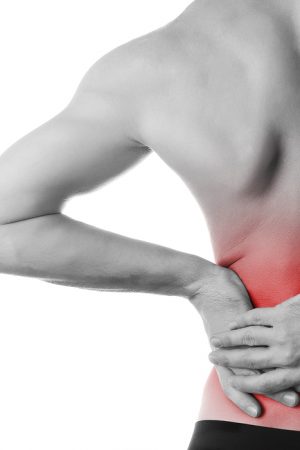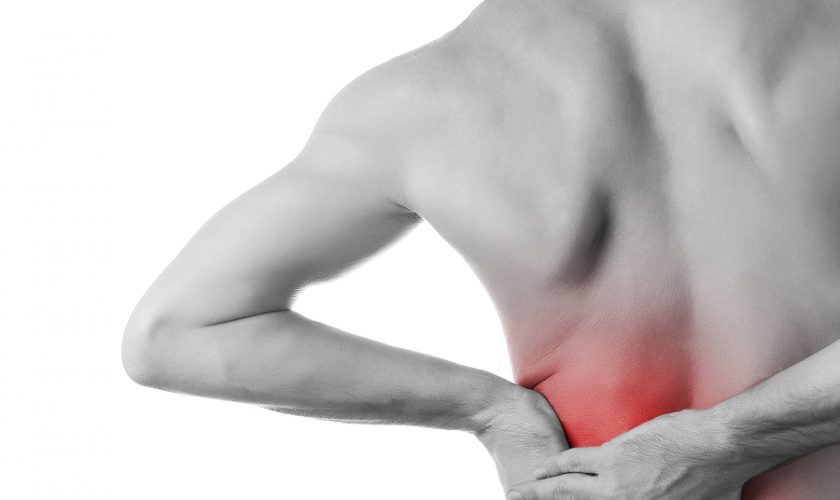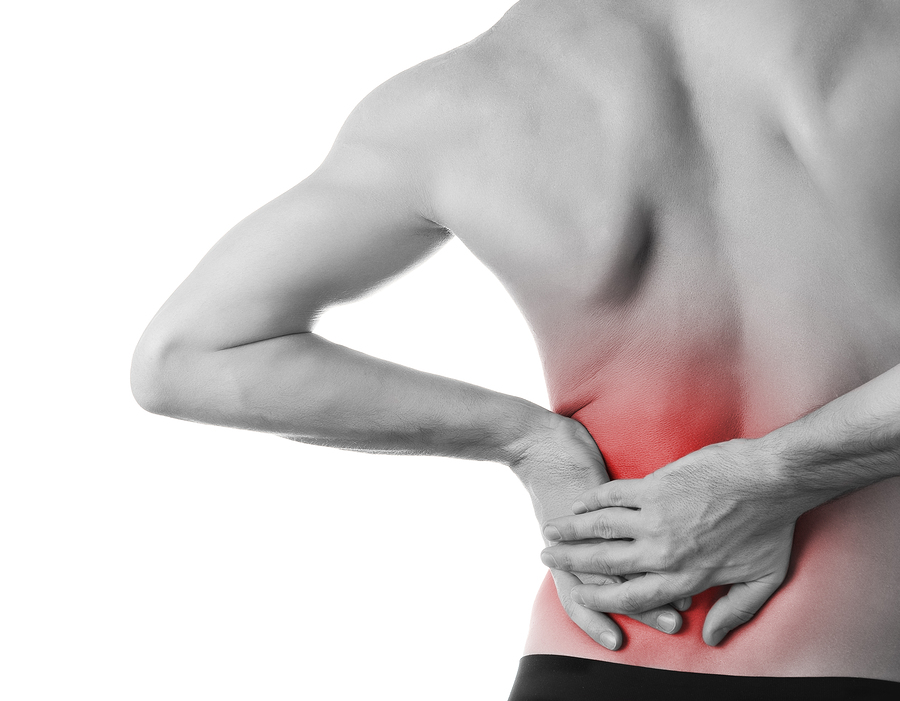Back pain includes lower back pain, middle back pain, upper back pain or low back pain with sciatica. Nerve and muscular problems, degenerative disc disease, and arthritis can result in back pain. Back pain symptoms may be relieved with pain medication or pain killers.
Facts
- Functions of the low back, or lumbar area, include structural support, movement, and protection of certain body tissues.
- Pain in the low back can be a result of conditions affecting the bony lumbar spine, discs between the vertebrae, ligaments around the spine and discs, spinal cord and nerves, muscles of the low back, internal organs of the pelvis and abdomen, and the skin covering the lumbar area.
- Treatment of low back pain is optimally directed toward a diagnosed or suspected specific cause. For acute lumbar strain, use of a home remedy initially can be beneficial.
Symptoms
The main symptom of back pain is, as the name suggests, an ache or pain anywhere on the back, and sometimes all the way down to the buttocks and legs. In most cases signs and symptoms clear up on their own within a short period.
Signs and symptoms of back pain may include:
- Muscle ache
- Shooting or stabbing pain
- Pain that radiates down your leg
- Limited flexibility or range of motion of the back
Types
Usually back pain is categorized into two types:
Acute Back Pain
Pain comes on suddenly and persists for a maximum of three months.
Chronic Back Pain
The pain gradually develops over a longer period, lasts for over three months, and causes long-term problems.
A considerable percentage of patients with back pain experience both occasional bouts of more intense pain as well as more-or-less continuous mild back pain, making it harder for the doctor to determine whether they have acute or chronic back pain.
Causes
Often it’s not possible to identify the cause of back pain. Doctors call this “non-specific” back pain.
Sometimes the pain may be a result of an injury such as a sprain or strain, but often it occurs for no apparent reason. It’s very rarely caused by anything serious.
Occasionally back pain can be due to a medical condition such as:
- a slipped (prolapsed) disc – where a disc of cartilage in the spine presses on a nearby nerve
- sciatica – irritation of the nerve that runs from the pelvis to the feet
These conditions tend to cause additional symptoms – such as numbness, weakness or a tingling sensation – and they’re treated differently to non-specific back pain.
Remedies
Limit Bed Rest
Studies show that people with short-term low-back pain who rest feel more pain and have a harder time with daily tasks than those who stay active.
“Patients should avoid more than three days of bed rest,” says Mike Flippin, MD, an orthopaedic surgeon who specializes in back and spine care at San Diego Medical Center. “I encourage my patients to get moving as quickly as possible.”
Keep Exercising
Activity is often the best medicine for back pain. “Simple exercises like walking can be very helpful,” Wilmarth says. “It gets people out of a sitting posture and puts the body in a neutral, upright position.”
But remember to move in moderation, Flippin says. “Stay away from strenuous activities like gardening and avoid whatever motion caused the pain in the first place.”
Maintain Good Posture
The pain may have started after a long workout at the gym, but the strain that caused it has probably been building for years. Wilmarth says most people have poor posture when going about their daily activities, putting unnecessary strain on their backs.
“Little things add up,” she says. “You can increase the pressure on your back by 50% simply by leaning over the sink incorrectly to brush your teeth. Keeping the right amount of curvature in the back takes pressure off the nerves and will reduce back pain.”
Strengthen Your Core
Most people with chronic back pain would benefit from stronger abdominal muscles.
“The torso is a combination of many muscle groups working together,” Frank B. Wyatt, EdD, professor of exercise physiology at Missouri Western State University, tells WebMD in an email. “If the abdominals are weak, other areas must pick up the slack. When we strengthen the abdominals, it often reduces the strain on the lower back.”
Improve Flexibility
Too much tension and tightness can cause back pain. “Our goal in increasing flexibility is to put an equal load throughout the body from the feet all the way up to the head,” Davis says. “One good exercise is to sit on the edge of the bed with one leg extended and the other one on the floor. Give your hamstrings a stretch by leaning forward while keeping your back in a neutral position.”
Focus on your feet
Some back trouble starts from the ground up. Women whose feet roll inward when they walk (what’s known as pronation) might be particularly susceptible to lower-back pain, according to a recent study in the journal Rheumatology. Another study finds that correcting the problem with orthotics may help.
Apply Ice and Heat
Heating pads and cold packs can comfort tender trunks. Most doctors recommend using ice for the first 48 hours after an injury — particularly if there is swelling — and then switching to heat.
But “it is difficult to say if ice or heat is more beneficial,” Flippin says. “I recommend that patients use whichever they find comforting as long as their skin is protected.”
Sleep the Right Way
The amount of rest you get is important, and so is the position you get it in. “Sleeping in a bad position or on a mattress without support can cause back pain,” Wilmarth says.
Some pointers:
- Back sleepers should put pillows under their knees.
- Side sleepers should place pillows between their knees to keep their spine in a neutral position.
- Stomach sleeping causes the neck and head to twist and can put undue stress on the back.
Quit Smoking
Lighting up doesn’t just damage your lungs; it can also hurt your back.
A study recently published in the American Journal of Medicine found that current and former smokers are more likely to have back pain when compared with people who have never smoked.
“Nicotine causes the small blood vessels to constrict and decreases the delivery of blood to the soft tissue,” Flippin says. “I tell all my patients that quitting smoking could help alleviate their back pain.”
Try Talk Therapy
Back pain is often seen with issues such as depression and anxiety, says Alex Moroz, MD, associate professor of rehabilitation medicine at NYU Langone Medical Center.
“Your emotional state colors the perception of pain,” Moroz says. “Therapy can be a helpful part of rehabilitation.”
Use Relaxation Techniques
Research shows that practices such as meditation, deep breathing, tai chi, and yoga, which help put the mind at rest, can do wonders for the back.
“If you can induce a relaxation response, it will help reduce the perceived pain level,” Moroz says.
Ginger
Ginger root, which is used to cure vomiting, can also be used in the treatment of back pain. The anti-inflammatory compounds in ginger can give you relief from a backache.
Basil Leaves
Basil leaves can also come to your rescue when suffering from a backache.
Poppy Seeds
Poppy seeds work wonders as remedy of backache.
Herbal Oil
Massaging your back with an herbal oil can help your muscles relax and relieve pain. You can use any herbal oil such as eucalyptus oil, almond oil, olive oil or coconut oil. Heat the oil until warm and massage it gently over the aching area.
Garlic
Garlic is another ingredient that can help treat a backache. Simply eat two to three cloves of garlic every morning on empty stomach. You can also massage your back with garlic oil.
Wheat
Wheat has compounds that produce an analgesic effect that can help minimize pain.
Epsom Salt
Epsom salt can ease pain and relieve inflammation.
Chamomile Tea
A hot cup of chamomile tea will help relax tense muscle tissues that can be the cause or a related symptom of a backache. You can buy pre-packaged chamomile tea or make your own.
Milk
Milk is a rich source of calcium that your body needs for strong bones and healthy muscles. Ensuring that your body gets an adequate amount of calcium can help alleviate and prevent backaches.



